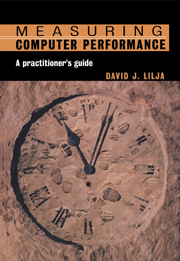Book contents
- Frontmatter
- Contents
- Preface
- Acknowledgements
- 1 Introduction
- 2 Metrics of performance
- 3 Average performance and variability
- 4 Errors in experimental measurements
- 5 Comparing alternatives
- 6 Measurement tools and techniques
- 7 Benchmark programs
- 8 Linear-regression models
- 9 The design of experiments
- 10 Simulation and random-number generation
- 11 Queueing analysis
- Appendix A Glossary
- Appendix B Some useful probability distributions
- Appendix C Selected statistical tables
- Index
2 - Metrics of performance
Published online by Cambridge University Press: 15 December 2009
- Frontmatter
- Contents
- Preface
- Acknowledgements
- 1 Introduction
- 2 Metrics of performance
- 3 Average performance and variability
- 4 Errors in experimental measurements
- 5 Comparing alternatives
- 6 Measurement tools and techniques
- 7 Benchmark programs
- 8 Linear-regression models
- 9 The design of experiments
- 10 Simulation and random-number generation
- 11 Queueing analysis
- Appendix A Glossary
- Appendix B Some useful probability distributions
- Appendix C Selected statistical tables
- Index
Summary
‘Time is a great teacher, but unfortunately it kills all its pupils.’
Hector BerliozWhat is a performance metric?
Before we can begin to understand any aspect of a computer system's performance, we must determine what things are interesting and useful to measure. The basic characteristics of a computer system that we typically need to measure are:
a count of how many times an event occurs,
the duration of some time interval, and
the size of some parameter.
For instance, we may need to count how many times a processor initiates an input/output request. We may also be interested in how long each of these requests takes. Finally, it is probably also useful to determine the number of bits transmitted and stored.
From these types of measured values, we can derive the actual value that we wish to use to describe the performance of the system. This value is called a performance metric.
If we are interested specifically in the time, count, or size value measured, we can use that value directly as our performance metric. Often, however, we are interested in normalizing event counts to a common time basis to provide a speed metric such as operations executed per second. This type of metric is called a rate metric or throughput and is calculated by dividing the count of the number of events that occur in a given interval by the time interval over which the events occur. Since a rate metric is normalized to a common time basis, such as seconds, it is useful for comparing different measurements made over different time intervals.
- Type
- Chapter
- Information
- Measuring Computer PerformanceA Practitioner's Guide, pp. 9 - 24Publisher: Cambridge University PressPrint publication year: 2000

